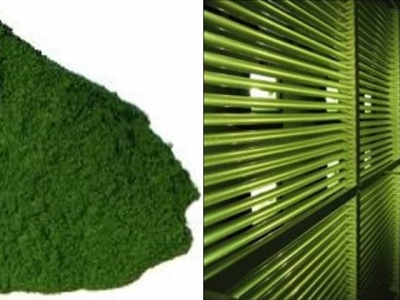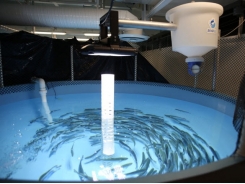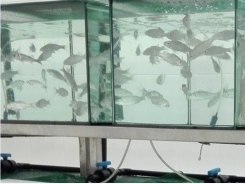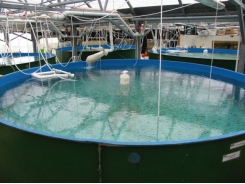Evaluating Nannochloropsis-based feeds for tilapia

Nutritional assessment shows adequate growth, survival, FCR and enhanced EPA levels
Due to its favorable protein and lipid content, and availability, the microalga Nannochloropsis salina (dry product, left) – which can be produced in bioreactors (right) – is a promising alternative ingredient for aquafeeds as well as various industrial applications.
Aquaculture growth has resulted in increased demand for feeds that traditionally depended greatly on fishmeal and fish oil as the main source of protein and lipids, but these supplies are finite. On a positive note, there are already several choices of protein substitutes on the market, including animal byproducts and plant proteins.
However, very few resources contain the long chain polyunsaturated fatty acids eicosapentaenoic acid (EPA) and docosahexaenoic acid (DHA). Without the DHA and EPA in aquafeeds, the end products would also lack these long chain omega-3 fatty acids, an important nutritional element of fish and seafood for humans.
Freshwater algae like Chlorella and Spirulina seem to have good potential as protein sources, whereas marine microalgae such as Nannochloropsis, Tetraselsmis or the heterotroph Schitzochytrium are the fundamental sources of EPA and DHA. As fish oil supply is limited, marine algal biomass is being considered as one of the alternative ingredients of the future.
This study examined the efficacy and nutritional properties of the marine alga Nannochloropsis salina as a feed ingredient using tilapia (Oreochromis niloticus) as a model species. Nannochloropsis was chosen because it contains both favorable protein (43 percent) and lipid levels (16.6 percent) with a high content of EPA (16 percent of total lipid).
Experimental setup
Genetically male Nile tilapia (GMT) sourced as fry and raised at the Centre for Sustainable Aquaculture Research at Swansea University were used for the trial. The trial was set up indoors as part of a freshwater recirculation system, which included mechanical and bio-filtration units, a protein skimmer and a sand filter. Water temperature was kept at 27 degrees-C and photoperiod was set at 12 hours of light daily. Temperature and dissolved-oxygen levels were measured daily, while total ammonia nitrogen, nitrite, nitrate and pH were measured weekly.
A total of 15 tilapia (12.8 grams per fish) were stocked into each of 12 tanks, with three replicates per treatment. Feeds were formulated to contain 35 percent protein and 13 percent lipid in such a way that both protein and lipid in a dietary treatment originated from the same source. In the first diet, protein and lipid was solely from fishmeal and fish oil; the second diet was based on soybean meal and soybean oil, and in the third diet, the protein and lipid source were entirely based on Nannochloropsis salina (Table 1).
Lupatsch, Nannochloropsis, Table 1
| Ingredients | Fishmeal based | Soybean based | Nannochloropsis based |
| FORMULATION | |||
| Fishmeal | 550 | - | - |
| Soybean | - | 800 | - |
| Nannochloropsis * | - | - | 820 |
| Fish oil | 100 | - | - |
| Soybean oil | - | 123 | - |
| Corn starch | 315 | - | 105 |
| Vitamins, Minerals | - | 5 | 5 |
| Dicalciumphosphate | - | 45 | 40 |
| Binder | 30 | 30 | 30 |
| COMPOSITION | |||
| Dry matter (grams) | 926 | 921 | 929 |
| Crude protein (grams) | 365 | 362 | 351 |
| Lipid (grams) | 138 | 128 | 138 |
| Ash (grams) | 126 | 96 | 94 |
| Gross energy (MJ) | 19.25 | 19.02 | 19.30 |
Table 1. Formulation and composition of experimental feeds (per kg as fed).
*Composition of Nannochloropsis (freeze dried): dry matter 979 g, crude protein 428 g, lipid 166 g, ash 67 g, GE 21.95 MJ per kg
Feeds were prepared by mixing the dry ingredients with binder and water, extruded through a meat grinder and afterwards dried at 45 degrees-C in an oven for 24 hours. The resulting pellets had a diameter of 2.5 mm and were stable for up to 24 hours in water.
The trial lasted for 36 days. Fish were fed to apparent satiation manually up to four times daily, and any uneaten pellets were collected at the end of the day and accounted for. Fish were sampled initially and at the end of the growth trial for whole body analyses. In addition, the fatty acid contents of feeds and fish were analyzed in order to determine the accumulation in whole body in relationship to the dietary fatty acid in the feed.
Results
Results indicate an improved growth performance for fish fed the fishmeal-based feed; however, the fish on the Nannochloropsis diet performed just as well on the soybean-based feed (Table 2). Nannochloropsis was well accepted, as shown by the percent feed intake.
Lupatsch, Nannochloropsis, Table 2
| Treatment | Fishmeal based | Soybean based | Nannochloropsis based |
| Initial weight (g/fish) | 12.7 | 12.7 | 12.6 |
| Final weight (g/fish) | 42.2a | 39.4b | 39.8b |
| Weight gain (g/fish/day) | 0.82a | 0.74b | 0.75b |
| Feed intake (%/biomass/day) | 4.24a | 4.76b | 4.32a |
| FCR | 1.20a | 1.43c | 1.28b |
| Survival (%) | 97.8a | 95.6a | 97.8a |
Table 2. Performance parameters of tilapia after 36 days of growth at 27 degrees-C (mean of three replicate treatments).
a,b,c: superscripts in the same row indicate significant differences at P<0.05
Moreover, the feed conversion ratio of tilapia fed the algae was enhanced compared tilapia fed the soybean-based feed, indicating that less feed is needed, 1.28 kg, when it is based on Nannochloropsis compared to 1.43 kg when feed is based on soybean meal (Table 2). This is probably due to the complex and ingestible carbohydrate fraction in soybean meal, whereas in contrast, the high feed efficiency for fish fed the Nannochloropsis diet might indicate a high digestibility.
Fig.1 shows the fatty acid content (percent of total lipid) of the experimental feeds and of the whole bodies of tilapias fed the respective feeds before and after the feeding trial. Prior to the experiment, the fish had been fed a commercial feed containing fishmeal and fish oil.



Fig. 1: Profile of selected fatty acids in fish at the start and after the feeding period fed the three different feeds (expressed as percent of total lipid) (mean values ± SD).
In all treatments, the fatty acid profile of fish bodies was influenced by the fatty acid composition of the diets. As indicated in Fig. 1, the linoleic acid content (18:omega-6) of fish when fed the soy oil diet increased considerably, whilst the EPA level in fish bodies was enhanced when fed on Nannochloropsis, even surpassing the fish fed fishmeal diets.
Perspectives
Nannochloropsis shows promising potential as both a protein and lipid source for aquafeeds due to its favorable protein and lipid content, as well as its high availability. Digestibility was not determined in Nannochloropsis, but the improved FCR compared to soybean suggests that the algal cell walls are not restricting the digestion process. This is in contrast to Chlorella, which has very tough cell walls, as demonstrated previously by the first author.
On the down side, Nannochloropsis does not contain DHA; consequently, a possible strategy might be to formulate feeds in combination with a DHA-rich source such as the heterotroph Schitzochytrium.
However, to prove the potential of algal products, several hurdles must be overcome, especially to demonstrate that their production on a commercial scale is both feasible and cost-effective.
Related news
Tools

Phối trộn thức ăn chăn nuôi

Pha dung dịch thủy canh

Định mức cho tôm ăn

Phối trộn phân bón NPK

Xác định tỷ lệ tôm sống

Chuyển đổi đơn vị phân bón

Xác định công suất sục khí

Chuyển đổi đơn vị tôm

Tính diện tích nhà kính

Tính thể tích ao




 How to make the fish farming industry more…
How to make the fish farming industry more…  Tropical, subtropical marine fish hatchery technology needs improvement
Tropical, subtropical marine fish hatchery technology needs improvement